Poyang Lake Migratory Bird Sanctuary: A Birdwatcher’s Paradise in China
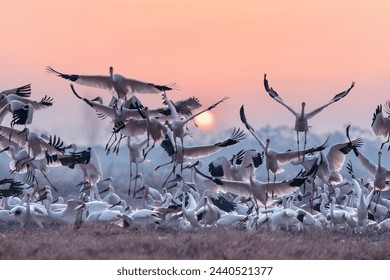
An Essential Guide to Visiting Poyang Lake Migratory Bird Sanctuary
In This Guide
- An Essential Guide to Visiting Poyang Lake Migratory Bird Sanctuary
- The Rich History and Legends of Poyang Lake Migratory Bird Sanctuary
- Main Highlights: What You Absolutely Can’t Miss
- Planning Your Visit: A Practical Guide
- Tickets: Prices, Booking, and Tips
- How to Get There: A Complete Transportation Guide
- Local Cuisine and Accommodation Nearby
- Frequently Asked Questions
- Final Thoughts on Your Trip
Discover the Enchantment of Poyang Lake
Nestled in the heart of Jiangxi Province, Poyang Lake is not just the largest freshwater lake in China; it is a vibrant sanctuary steeped in history, culture, and nature. Spanning an impressive 4,125 square kilometers, the lake is a breathtaking tableau where the azure waters meet the sky, creating a horizon that seems to stretch into eternity. Visitors often find themselves mesmerized, standing on the shores as sailboats glide through the shimmering surface, reminiscent of a scene from a painting.
For centuries, Poyang Lake has been a vital lifeline for the local communities, providing sustenance and inspiration. The lake’s rich ecosystem supports over 300 species of migratory birds, including the magnificent white crane, which draws birdwatchers and nature enthusiasts from around the world. Each winter, this extraordinary spectacle unfolds as nearly one million birds flock to the sanctuary, creating a living tapestry of life that captivates all who witness it.
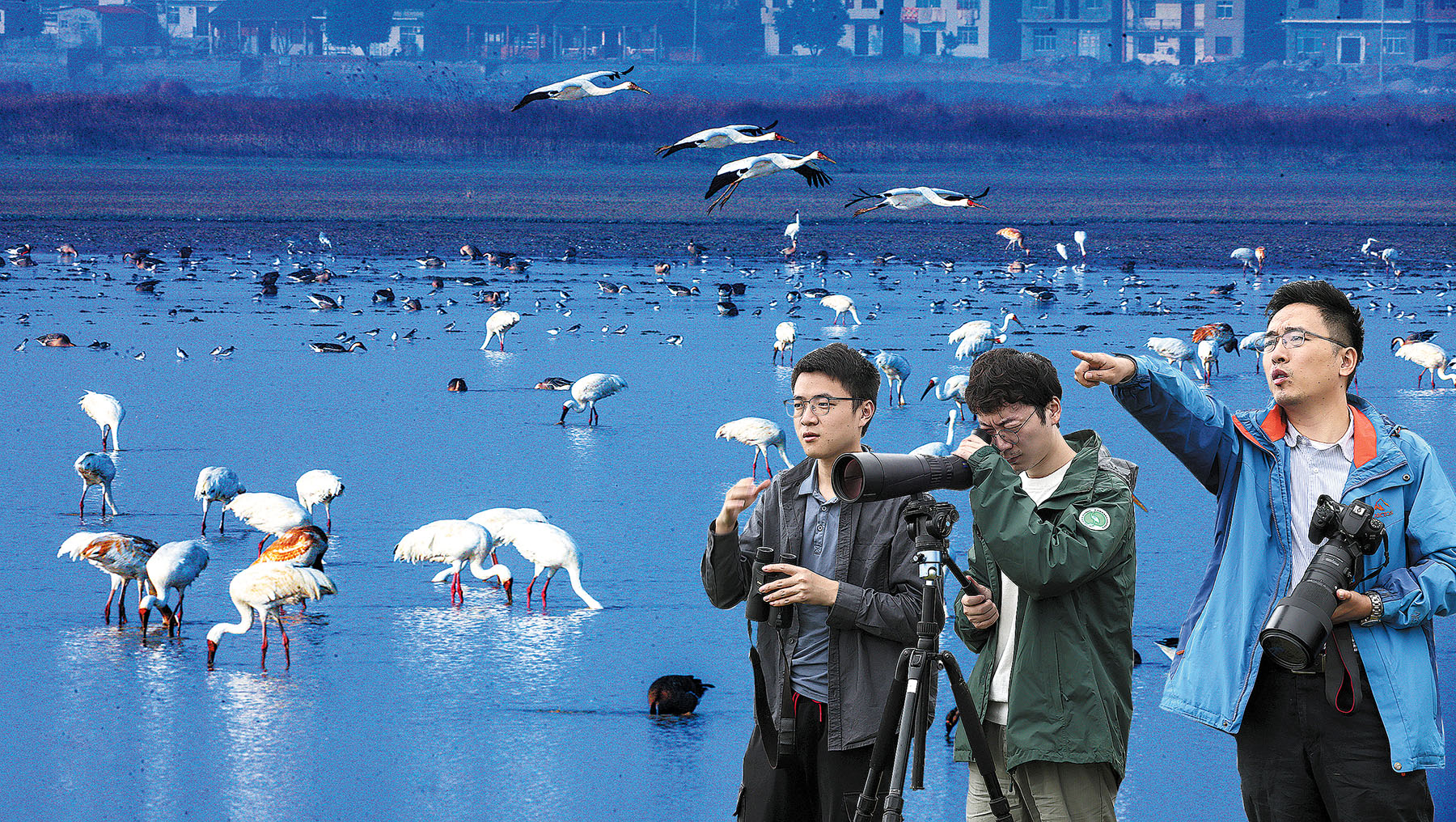
Poyang Lake Migratory Bird Sanctuary.
Beyond its natural allure, Poyang Lake is steeped in legends and historical significance. From the romantic tale of Dagu Hill—a mystical island that echoes with the whispers of a fairy’s love story—to the poignant history of the Lake-View Pavilion, where military strategies were devised in times of war, every corner of this sanctuary holds a narrative waiting to be uncovered.
As you embark on your journey to Poyang Lake Migratory Bird Sanctuary, prepare to immerse yourself in a world where nature and culture intertwine seamlessly. Whether you are a seasoned birdwatcher, a history buff, or simply a traveler eager for adventure, Poyang Lake promises a memorable experience that enriches both the mind and spirit.
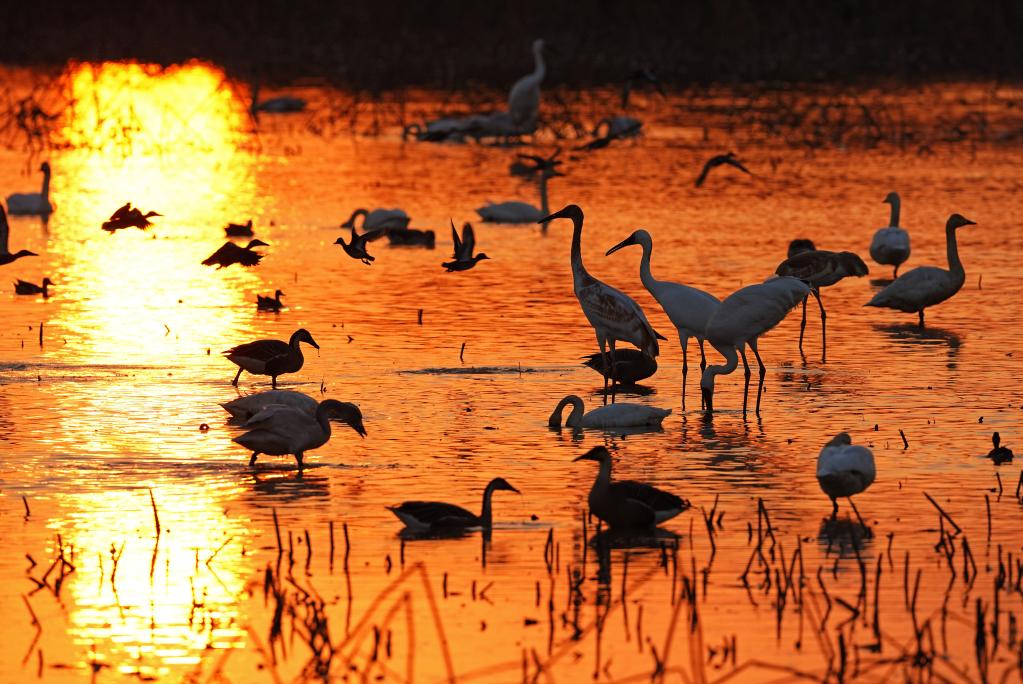
Poyang Lake Migratory Bird Sanctuary.
The Rich History and Legends of Poyang Lake Migratory Bird Sanctuary
Nestled in the heart of Jiangxi Province, the Poyang Lake Migratory Bird Sanctuary is not only a haven for nature lovers and birdwatchers but also a site steeped in rich history and enchanting legends. This sanctuary, the largest freshwater lake in China, serves as a refuge for countless migratory birds, especially the iconic white cranes, while also being a silent witness to the tales and traditions that have taken root alongside its shores.
The Historical Significance of Poyang Lake
Poyang Lake has long been associated with pivotal events in Chinese history. Its strategic location along the Yangtze River has made it a vital resource and a center for trade and agriculture. The lake’s waters have nurtured civilizations for thousands of years, providing bountiful fish and fertile land that have sustained local communities.

Poyang Lake Migratory Bird Sanctuary.
During the late Yuan Dynasty, Poyang Lake was the stage for one of the largest naval battles in Chinese history between General Chen Youliang and Zhu Yuanzhang, who later founded the Ming Dynasty. The Lake-View Pavilion, a wooden structure on the lake’s shore, offers a poignant glimpse into this historical chapter. Legend has it that during the battles, General Chen’s wife observed the conflict from this very pavilion, suggesting a clever stratagem that ultimately led to her husband’s victory. Tragically, a misunderstanding regarding a battle banner resulted in her untimely death, adding a layer of sorrow to the pavilion’s history.
Legends of Love and Sacrifice
The legends surrounding Poyang Lake are infused with themes of love, sacrifice, and the supernatural. One of the most cherished stories is that of Dagu Hill, an island in the lake shaped like a large shoe. According to the legend, a humble fisherman named Hu Qing encountered a fairy named Da Gu after he selflessly returned a treasured pearl to her. Their love blossomed, but it was not without trials; the jealous fishing overlord Sheng Tai sought to possess Da Gu for himself.
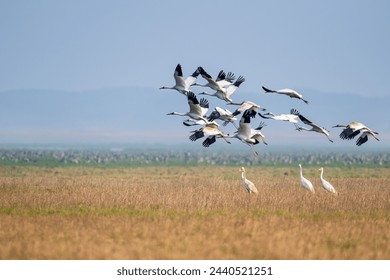
Poyang Lake Migratory Bird Sanctuary.
As Da Gu was whisked away to the heavens, she cast down her shoe in a desperate attempt to save her husband from Sheng Tai’s wrath. The shoe transformed into a massive rock that crushed Sheng’s forces, creating the very hill that bears her name today. This story not only emphasizes the lake’s mystical charm but also reflects the deep-seated cultural values of loyalty and sacrifice.
The Enchantment of Nature
Poyang Lake’s allure extends beyond its legends and history; it is also a sanctuary of natural beauty. Each winter, the lake transforms into a breathtaking spectacle as it plays host to nearly one million migratory birds, including 95% of the world’s white cranes. These elegant birds, with their striking white feathers and graceful movements, have earned the lake the endearing moniker of the “World of White Cranes.”
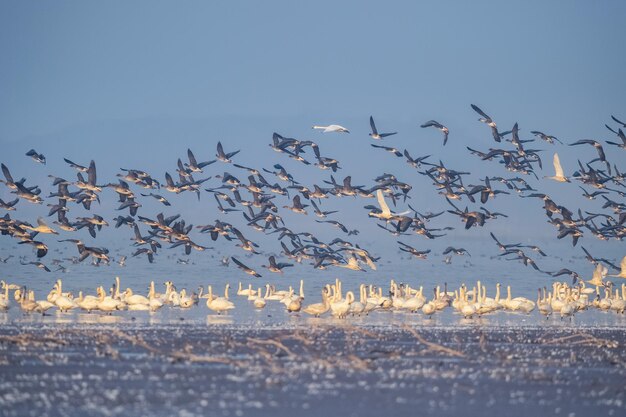
Poyang Lake Migratory Bird Sanctuary.
The white crane is a symbol of longevity and fidelity in Chinese culture, often associated with prosperity and good fortune. The sanctuary’s rich biodiversity, with over 300 bird species, makes it a paradise for birdwatchers and wildlife enthusiasts alike. Observing these magnificent creatures in their natural habitat is a profound experience that connects visitors to the ancient rhythms of nature.
Cultural Heritage and Scholarly Pursuits
Poyang Lake has also been a site of intellectual gathering throughout the ages. Luoxingshi Rock, a small island within the lake, is renowned as a meeting place for scholars and poets across different dynasties. The island’s temples and stone structures echo the voices of literary giants who once sought inspiration amidst its serene landscapes.
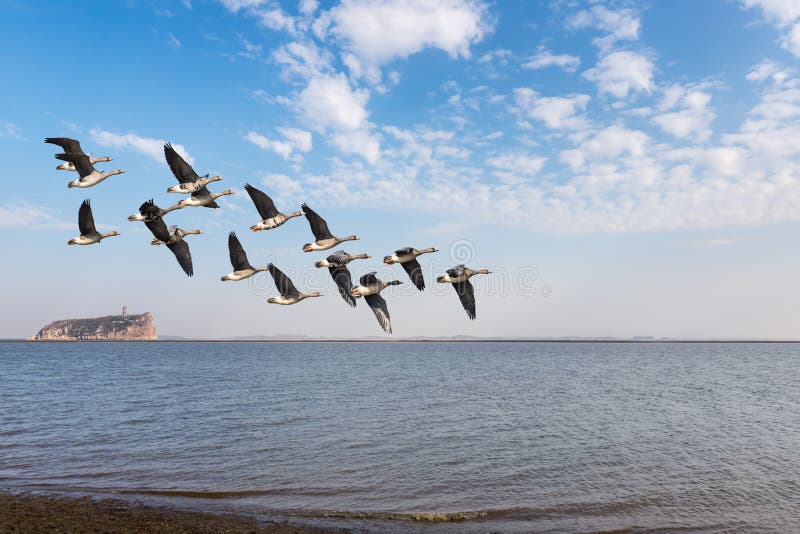
Poyang Lake Migratory Bird Sanctuary.
Visitors to Luoxingshi Rock can immerse themselves in the rich cultural heritage that has flourished here, reflecting a timeless connection between the natural world and human creativity.
Conclusion
The Poyang Lake Migratory Bird Sanctuary is a multifaceted gem, weaving together the threads of natural beauty, historical significance, and rich folklore. Whether you are drawn to its stunning wildlife, captivated by its legends of love and sacrifice, or intrigued by its historical narratives, Poyang Lake offers an unparalleled experience that resonates deeply with both the heart and mind. As you explore its shores, you will find that the sanctuary is not just a place of refuge for birds but also a vibrant tapestry of culture and history waiting to be discovered.
Main Highlights: What You Absolutely Can’t Miss
Discover the Wonders of Poyang Lake Migratory Bird Sanctuary
Poyang Lake, the largest freshwater lake in China, is not only a natural wonder but also a cultural and historical treasure. Nestled in Jiangxi Province, this expansive lake is a sanctuary for migratory birds and a captivating destination for travelers keen on experiencing the beauty of nature intertwined with rich Chinese heritage. Here’s a guide to the main highlights you absolutely cannot miss:
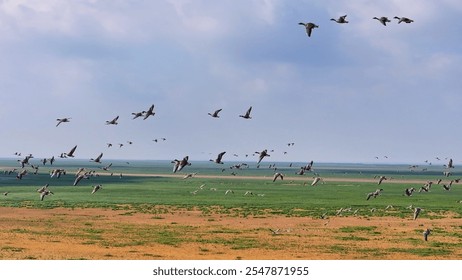
Poyang Lake Migratory Bird Sanctuary.
1. The Bird Sanctuary Experience
- World of White Cranes: Every winter, Poyang Lake transforms into a haven for migratory birds, hosting approximately 95% of the world’s white cranes. Witness these magnificent creatures as they flock to the lake from regions as far as Siberia and Mongolia. The spectacle of thousands of white cranes in flight is a breathtaking sight, making it a must-see for birdwatchers and nature lovers alike.
- Rare Bird Species: Aside from white cranes, the sanctuary is home to over 300 species of birds, including black storks, pelicans, and various wading birds. Bring your binoculars and immerse yourself in the vibrant avian life that thrives here.
2. Dagu Hill
- Known for its striking appearance resembling a large shoe floating on the lake, Dagu Hill is steeped in legend. Hike to the top for panoramic views of Poyang Lake, and explore the remnants of its historical significance as a gathering place for scholars. The hill offers a glimpse into ancient Chinese culture, complete with lush landscapes and captivating folklore.
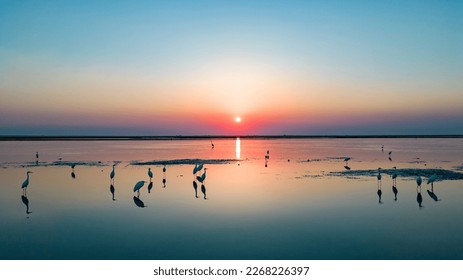
Poyang Lake Migratory Bird Sanctuary.
3. Nanshan Hill
- Rising dignified from the waters, Nanshan Hill is named after a humble wise man who once lived here during the Western Han Dynasty. Visitors can enjoy the clear spring water known as ‘farmer rock’ and take in stunning vistas of the lake. This site is perfect for those looking to blend natural beauty with a taste of historical reverence.
4. Lake-View Pavilion
- This picturesque pavilion offers splendid views of the confluence of the Xiu and Gan rivers. Steeped in history, it was originally built during the Eastern Han Dynasty and carries tales from the late Yuan Dynasty, where a strategic battle unfolded. The pavilion today serves as a poignant reminder of the region’s storied past while providing a tranquil spot to enjoy the surrounding scenery.
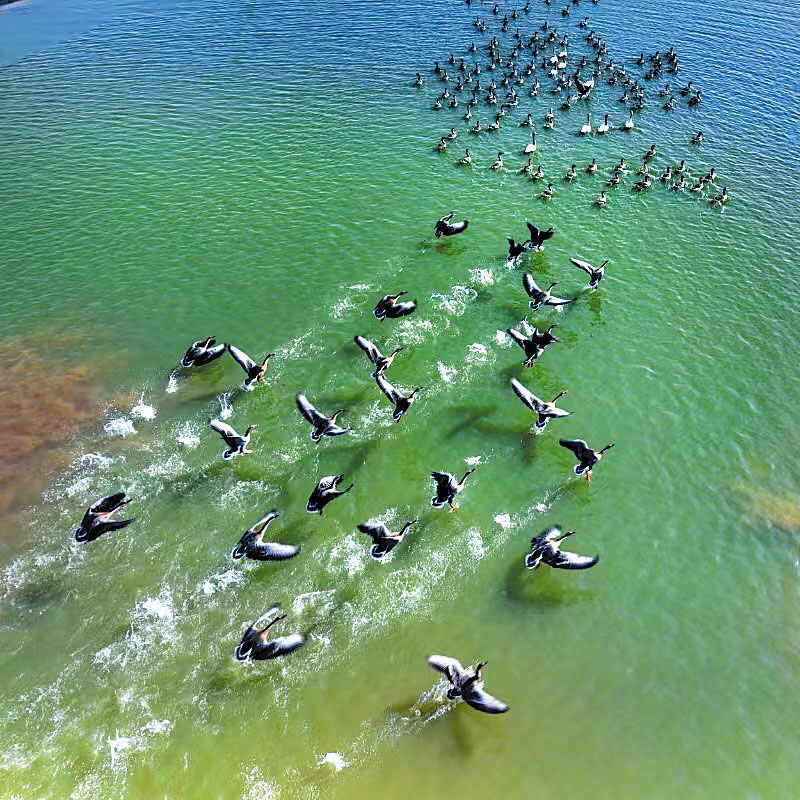
Poyang Lake Migratory Bird Sanctuary.
5. Luoxingshi Rock
- A small yet culturally rich island, Luoxingshi Rock has been a gathering place for scholars throughout the dynasties. The island’s temples and stone towers echo the literary heritage of the area and provide another serene spot for reflection amidst the natural beauty of Poyang Lake.
6. The Scenic Beauty of Poyang Lake
- The lake itself is a sight to behold, with its shimmering blue waters stretching to the horizon. Sailboats and rafts create a picturesque scene, while the surrounding landscape enhances the serenity of this natural paradise. On sunny days, the interplay of sky and water is nothing short of magical.
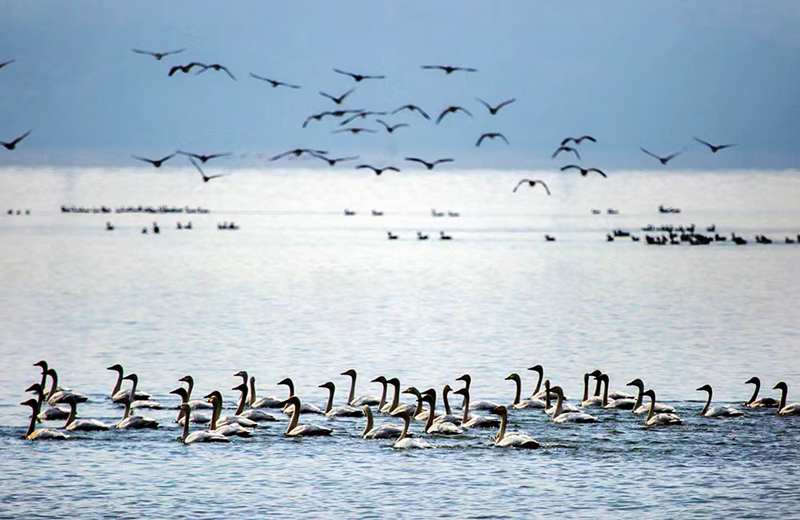
Poyang Lake Migratory Bird Sanctuary.
7. Cultural and Historical Significance
- Poyang Lake is not just a sanctuary for wildlife; it is a place where history and culture converge. The various legends associated with the hills and the lake, combined with the remnants of ancient buildings, provide a rich tapestry of stories waiting to be discovered.
8. Practical Information
- Admission Fee: The Wetland Park charges an entry fee of CNY 95, while boating excursions vary in price (CNY 50 for exterior or interior lakes, CNY 80 for both).
- Opening Hours: The sanctuary is open from 09:00 AM to 06:00 PM, offering ample time to explore its natural and historical wonders.
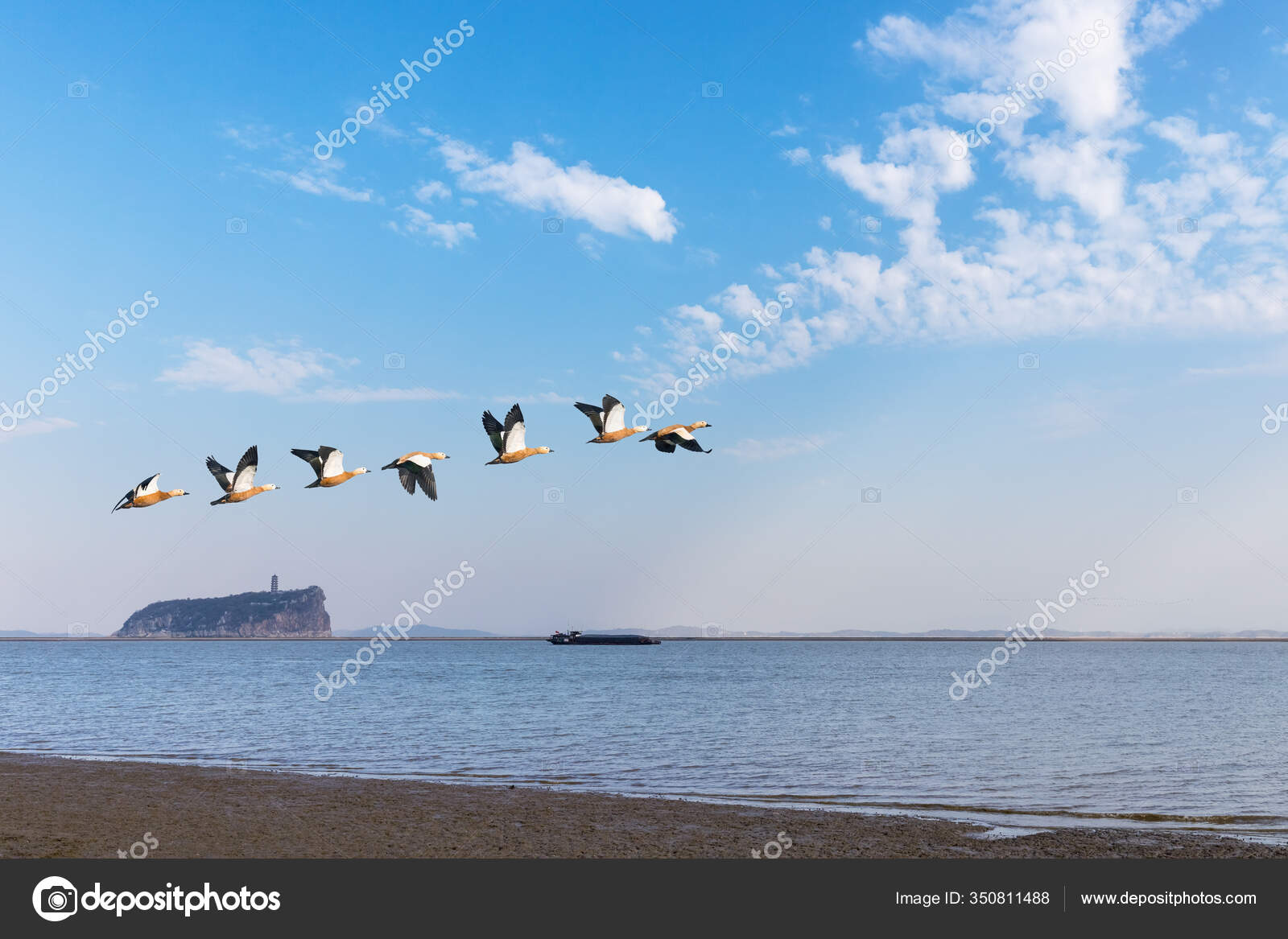
Poyang Lake Migratory Bird Sanctuary.
Visiting Poyang Lake Migratory Bird Sanctuary is an unforgettable experience, where you can witness the majestic beauty of nature while delving into the rich history and culture of China. Whether you’re a keen birdwatcher, a history buff, or simply seeking tranquility in nature, Poyang Lake promises a unique and enriching adventure.
Planning Your Visit: A Practical Guide
Your Guide to Visiting Poyang Lake Migratory Bird Sanctuary
Poyang Lake, the largest freshwater lake in China, is a mesmerizing destination that offers a unique blend of natural beauty, rich wildlife, and cultural history. Whether you’re a birdwatching enthusiast, a nature lover, or a history aficionado, this sanctuary has something to offer everyone. Here’s everything you need to know to make the most of your visit.
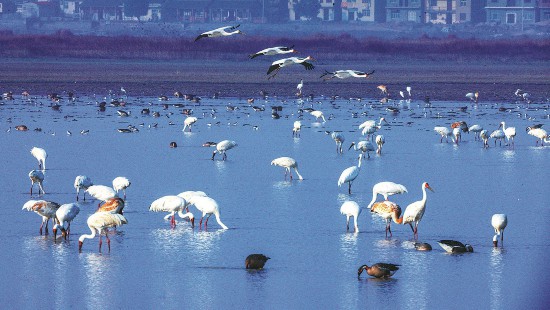
Poyang Lake Migratory Bird Sanctuary.
Getting There
Location: Poyang Lake is situated in Jiujiang City, Jiangxi Province, easily accessible by various modes of transport.
- By Air: The nearest airport is Jiujiang Lushan Airport, which is about 50 kilometers from the lake. From the airport, you can take a taxi or a bus to reach the sanctuary.
- By Train: Jiujiang Railway Station is well-connected to major cities in China, including Shanghai and Nanchang. Once in Jiujiang, local transport options like buses or taxis can take you to Poyang Lake.
- By Road: If you’re driving, take the G105 National Highway, which runs close to the lake. Well-marked signs will guide you to the sanctuary.
Best Time to Visit
Migratory Season: The best time to visit Poyang Lake is during the winter months, from November to March. This is when thousands of migratory birds, including the rare white cranes, arrive from Siberia and surrounding regions, turning the sanctuary into a vibrant avian paradise.
Weather: Jiujiang experiences a humid subtropical climate. Winters are mild, with temperatures ranging from 5°C to 15°C (41°F to 59°F), making it pleasant for exploration.
Admission and Fees
- Wetland Park: CNY 95
- Boating:
- CNY 50 for the exterior lake
- CNY 80 for both exterior and interior lakes
- Opening Hours: 09:00 AM to 06:00 PM
Exploring the Sanctuary
Birdwatching: Bring your binoculars and cameras to catch glimpses of the diverse bird species. The sanctuary is home to over 300 species, with nearly one million birds, making it the largest bird reserve in the world.
- Tip: For serious birdwatchers, a telescope is recommended, as many birds are shy and prefer to keep their distance.
Key Attractions:
-
Dagu Hill: Known as Shoe Hill, this island offers hiking trails and stunning views of the lake. Don’t miss the Heaven Flower Palace along the way.
-
Nanshan Hill: This hill has historical significance, offering fresh spring water and a panoramic view of Poyang Lake.
-
Lake-View Pavilion: A picturesque spot that played a role in a famous historical tale, it provides excellent views of the confluence of the Xiu and Gan rivers.
-
Luoxingshi Rock: A small rock island with a rich cultural heritage, featuring temples and stone structures that have attracted scholars throughout history.
Cultural Insights
Poyang Lake is not just about nature; it’s steeped in history and legend. Many local tales and folklore enrich the experience of visiting the sanctuary. Consider taking guided tours or engaging with local historians to learn more about the area’s heritage and the significance of its natural features.
Tips for a Memorable Visit
- Clothing: Dress in layers during winter, as temperatures can fluctuate. Comfortable shoes are essential for hiking.
- Photography: Early mornings and late afternoons provide the best lighting for photography. Respect wildlife and keep a safe distance when capturing images.
- Local Cuisine: Don’t miss trying local Jiangxi dishes at nearby restaurants. Freshwater fish and rice dishes are local specialties that capture the essence of the region.
Conclusion
A visit to Poyang Lake Migratory Bird Sanctuary promises an unforgettable experience filled with breathtaking landscapes, rich wildlife, and cultural depth. Whether you’re there for the birds, the history, or simply to enjoy the serene beauty of nature, Poyang Lake welcomes you to explore its wonders. Prepare your itinerary, pack your essentials, and get ready for an adventure that connects you deeply with one of China’s most remarkable natural treasures.
Tickets: Prices, Booking, and Tips
When planning your visit to the breathtaking Poyang Lake Migratory Bird Sanctuary, understanding the ticketing details, booking process, and insider tips can enhance your experience. This renowned sanctuary not only offers stunning natural beauty but is also a haven for birdwatchers and nature enthusiasts alike.
Admission Fees
To explore the wonders of Poyang Lake, you’ll need to purchase tickets that provide access to various areas of the sanctuary:
- Wetland Park Admission: CNY 95
- Boating Fees:
- Exterior Lake Only: CNY 50
- Interior Lake Only: CNY 80
- Both Exterior and Interior Lakes: CNY 130
Opening Hours
The sanctuary is open to visitors from 09:00 AM to 06:00 PM. It’s advisable to arrive early to make the most of your day, as the early morning hours are often the best for birdwatching.
Booking Information
Tickets can typically be purchased at the entrance of the sanctuary, but to ensure a smooth experience, especially during peak migratory seasons (November to March), consider the following:
- Online Booking: Some travel platforms and local tourism websites offer the option to book tickets in advance. This can save you time and guarantee your entry during busy periods.
- Local Tours: Joining a guided tour can enhance your experience significantly. Many tour operators in Jiujiang offer packages that include transportation, entrance fees, and knowledgeable guides who can provide insights into the local ecosystem and bird species.
Tips for a Memorable Visit
- Best Time for Birdwatching: If your primary goal is birdwatching, plan your visit between late November and early March when the sanctuary hosts the largest concentration of migratory birds, including the majestic white cranes.
- Bring Binoculars: While the birds can often be seen with the naked eye, binoculars or a camera with a zoom lens will enhance your viewing experience, allowing you to appreciate the finer details of these beautiful creatures.
- Dress Appropriately: The weather can vary greatly depending on the season. Dress in layers and wear comfortable shoes, as you may want to explore various trails and viewpoints within the sanctuary.
- Respect Wildlife: While it’s tempting to get close to the birds for a photo, remember to keep a respectful distance to avoid disturbing them, especially during nesting season.
- Capture the Moment: Don’t forget your camera! The picturesque landscapes, especially at sunrise and sunset, provide incredible photo opportunities.
By understanding the ticket prices, opening hours, and practical tips for your visit, you can fully immerse yourself in the enchanting world of Poyang Lake — a true gem of China’s natural heritage. Enjoy your journey into this vast sanctuary and the rich tapestry of history and culture that surrounds it!
How to Get There: A Complete Transportation Guide
Navigating Your Way to Poyang Lake Migratory Bird Sanctuary
Poyang Lake Migratory Bird Sanctuary, located in the scenic Jiujiang City of Jiangxi Province, is a treasure trove for birdwatchers and nature enthusiasts alike. To fully appreciate the natural beauty and cultural significance of this area, understanding how to get there is crucial. Here’s a detailed transportation guide to ensure your journey is smooth and enjoyable.
Getting to Jiujiang City
By Air:
The nearest airport to Poyang Lake is Jiujiang Lushan Airport (JIU), located approximately 30 kilometers from downtown Jiujiang. This airport is served by a variety of domestic flights, primarily from major cities such as Beijing, Shanghai, and Guangzhou.
- Airport Transfer:
- Taxi: The most convenient way to reach the city is by taxi, which should take around 30 minutes.
- Airport Shuttle: Check for shuttle bus services that may operate between the airport and Jiujiang city center.
By Train:
Jiujiang is well-connected by rail, making it accessible from several key locations across China. The Jiujiang Railway Station serves both high-speed and regular trains.
- From Nanchang: High-speed trains run frequently, with a journey time of about 1 hour.
- From Wuhan: Direct trains are available, taking approximately 4 hours.
- From Shanghai: You can take a high-speed train to Nanchang and transfer to Jiujiang, with the total travel time around 5-6 hours.
By Bus:
Buses to Jiujiang operate from various cities, including Nanchang and Wuxue.
- From Nanchang: Long-distance buses depart from the Nanchang Bus Station, taking around 2-3 hours to reach Jiujiang.
- From Wuxue: Regular bus services are available, taking about 3 hours.
Getting to Poyang Lake
Once you arrive in Jiujiang, accessing Poyang Lake is straightforward:
By Taxi:
Taxis are readily available in Jiujiang. You can easily find one to take you directly to the Poyang Lake Migratory Bird Sanctuary, which is roughly 15 kilometers from the city center. The ride should take around 20-30 minutes.
By Bus:
Public buses also connect Jiujiang to various points near Poyang Lake. Look for buses heading toward Duchang County or Suojiang Town, both of which are close to the sanctuary.
- Bus Station: Buses usually depart from the Jiujiang Long-Distance Bus Station.
- Ticket Price: The fare is typically inexpensive, around CNY 10-20.
By Tour Services:
Many tour operators in Jiujiang offer packages that include transportation to Poyang Lake. This option can provide added convenience, especially for international travelers who prefer guided experiences.
Tips for Visiting
- Best Time to Visit: The sanctuary is particularly vibrant during the winter months, from November to March, when migratory birds, including the rare white cranes, populate the area.
- Entrance Fees: The Wetland Park charges an entrance fee of CNY 95. Boating trips around the lake are also available, with fees ranging from CNY 50 to CNY 80 depending on the route.
- Local Accommodations: Consider staying in Jiujiang City, where you’ll find a range of hotels catering to different budgets, or opt for a guesthouse near the lake for a more immersive experience.
Conclusion
Whether you arrive by air, train, or bus, reaching Poyang Lake Migratory Bird Sanctuary is an engaging journey filled with opportunities to witness the beauty of Jiangxi Province. With this transportation guide, you’re well-equipped to explore this remarkable habitat and immerse yourself in its rich tapestry of history and culture. Prepare for breathtaking views, fascinating birdwatching, and unforgettable memories!
Local Cuisine and Accommodation Nearby
Exploring the Poyang Lake Migratory Bird Sanctuary is not just about witnessing the awe-inspiring sights of nature; it’s also an opportunity to indulge in local cuisine and find comfortable accommodations nearby. Here’s your guide to savoring the flavors of Jiangxi Province and resting well after a day of birdwatching.
Culinary Delights of Jiangxi
Jiangxi cuisine, known for its bold flavors and emphasis on fresh ingredients, offers a delightful culinary experience that reflects the region’s agricultural bounty and rich cultural heritage. Here are some local dishes and food experiences you should not miss:
-
Nanchang Rice Noodles (南昌米粉): These delicate rice noodles are a staple in Jiangxi cuisine. Served with a variety of toppings such as braised meats, pickled vegetables, and aromatic herbs, this dish is perfect for a quick and satisfying meal.
-
Jiangxi Fish Head Soup (江西鱼头汤): With Poyang Lake’s abundance of freshwater fish, a steaming bowl of fish head soup is a must-try. This dish features tender fish heads simmered with spices and herbs, providing a rich and flavorful broth.
-
Stir-Fried Bamboo Shoots (炒竹笋): Fresh bamboo shoots harvested from the lush surroundings are often stir-fried with garlic and chili, showcasing the natural sweetness of the shoots and the region’s love for fresh vegetables.
-
Gan Cuisine (赣菜): Don’t leave without trying other local specialties like spicy fried fish, steamed buns, and various pickled vegetables. The balance of heat and flavor in Gan cuisine is sure to tantalize your taste buds.
-
Street Food: While exploring the area, sample local street food offerings such as fried rice cakes and sweet potato balls from vendors. These snacks are not only delicious but also provide a glimpse into the everyday life of locals.
Where to Stay
After a day of birdwatching and culinary exploration, you’ll want a comfortable place to unwind. Here are some recommended accommodations near Poyang Lake:
-
Jiujiang Banshan Hotel (九江半山酒店): Located just a short drive from Poyang Lake, this hotel offers modern amenities and beautiful views of the surrounding landscape. The on-site restaurant serves local cuisine, making it a convenient choice for guests.
-
Poyang Lake Eco-Tourism Resort (鄱阳湖生态旅游度假区): Emphasizing environmental sustainability, this resort provides eco-friendly accommodations surrounded by nature. Enjoy outdoor activities and relax in comfortable lodgings after a day of exploring.
-
Lushan Mountain Scenic Area Hotels (庐山风景区酒店): If you’re keen to visit the nearby Lushan Mountain, a range of hotels and guesthouses are available, catering to various budgets. Enjoy the breathtaking views and experience the serene atmosphere.
-
Local Guesthouses: For a more intimate experience, consider staying in one of the charming guesthouses near the lake. These family-run establishments often provide homemade meals and a chance to connect with local culture.
Conclusion
Whether you’re indulging in the rich flavors of Jiangxi cuisine or relaxing in comfortable accommodations, the Poyang Lake Migratory Bird Sanctuary offers a holistic experience that intertwines nature, culture, and gastronomy. Embrace the local heritage and make lasting memories during your visit!
Frequently Asked Questions
Frequently Asked Questions About Poyang Lake Migratory Bird Sanctuary
1. What is Poyang Lake known for?
Poyang Lake, located in Jiangxi Province, is renowned as the largest freshwater lake in China and a vital sanctuary for migratory birds. It hosts the world’s largest population of wintering white cranes and over 300 species of birds, making it a paradise for birdwatchers and nature enthusiasts.
2. When is the best time to visit Poyang Lake?
The ideal time to visit is from November to March, when migratory birds, including the endangered white cranes, flock to the area. This period offers exceptional opportunities for birdwatching as the lake becomes a vibrant hub for various avian species.
3. How can I get to Poyang Lake?
Poyang Lake is accessible by train and bus from major cities in Jiangxi Province, such as Nanchang and Jiujiang. The nearest airport is Nanchang Changbei International Airport, from where you can take a train or bus to reach the lake.
4. Are there any entrance fees for the sanctuary?
Yes, there is an admission fee of CNY 95 for the Wetland Park. If you wish to explore the lake by boat, the fees range from CNY 50 to CNY 80, depending on whether you choose to visit the interior or exterior sections of the lake.
5. What facilities are available for visitors at Poyang Lake?
The sanctuary offers a variety of facilities, including observation decks, birdwatching platforms, and guided boat tours. There are also visitor centers where you can learn more about the local ecology and the significance of the migratory birds.
6. Can I participate in birdwatching activities?
Absolutely! Poyang Lake is a haven for birdwatchers. You can bring your binoculars or hire a local guide who can provide insights into the best spots and times for observing various bird species.
7. What should I wear and bring for my visit?
Dress in layers, as temperatures can vary greatly, especially in winter. Comfortable walking shoes are recommended for exploring the trails. Don’t forget to bring binoculars, a camera for photography, and water to stay hydrated during your excursions.
8. Are there any legends associated with Poyang Lake?
Yes, Poyang Lake is steeped in local legends, including the tale of Dagu Hill, which tells the story of a fisherman and a fairy. Such stories enrich the cultural experience of visiting the lake, offering a glimpse into the region’s rich history and folklore.
Final Thoughts on Your Trip
As you wrap up your journey through the breathtaking Poyang Lake Migratory Bird Sanctuary, a unique tapestry of natural beauty, rich history, and vibrant culture will undoubtedly linger in your mind.
Reflecting on Your Experience
Your adventure here has not merely been a sightseeing trip; it has been a deep dive into a world where nature and legend intertwine. From the majestic white cranes that grace the skies each winter to the enchanting stories of Dagu Hill and Nanshan Hill, each element of Poyang Lake tells a tale that resonates with the essence of Chinese culture and history.
-
Nature’s Sanctuary: The calm waters and diverse ecosystems provide a sanctuary not just for birds but for all who seek solace in nature’s embrace. The sight of flocks of migratory birds soaring overhead is a reminder of the interconnectedness of life and the importance of preserving such precious habitats.
-
Cultural Richness: The legends surrounding the hills and the historical significance of places like Lake-View Pavilion enrich your visit, offering a glimpse into the enduring spirit of the region. These stories are etched into the land, waiting to be discovered and celebrated by each new visitor.
-
A Call to Action: As travelers, we have a responsibility to protect and cherish the natural and cultural wonders we explore. Your visit to Poyang Lake not only creates lasting memories but also contributes to the ongoing efforts to safeguard this extraordinary ecosystem.
A Journey Worth Repeating
In closing, your trip to the Poyang Lake Migratory Bird Sanctuary is a reminder that adventure lies not only in the destinations we choose but in the stories we gather along the way. May you carry these memories with you, inspiring others to explore the beauty of Jiangxi Province and the wonders of China’s cultural heritage. Whether you find yourself reminiscing about the serene landscapes or the laughter of fellow travelers, let this journey spark a desire for further exploration—there are always new horizons waiting just beyond the next hill.
Safe travels and happy adventuring!